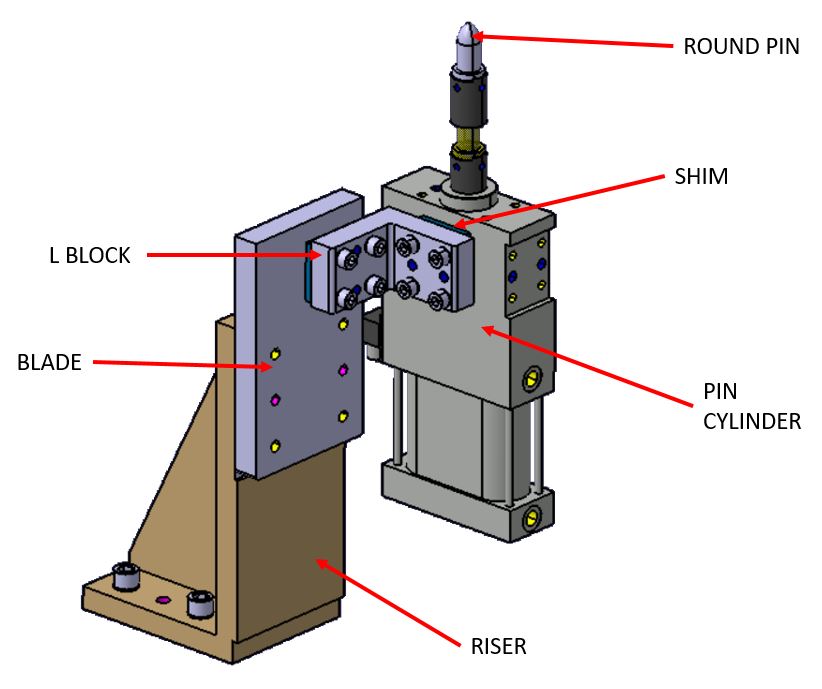Fix Pin Unit
A “Pin unit” is an assembly comprised of standard and manufacturing parts, specifically featuring a location pin. When the position of the pin within the unit remains fixed, it is termed a “Fixed Pin Unit.” The primary purpose of a pin unit is to secure the rotational position of a panel. In this context, a “Round Pin” is employed to regulate the panel’s movement in two directions, while a “Diamond Pin” is utilized for control in one direction. This design ensures effective and precise management of the panel’s positioning.
Shimming is used for controlling the pin in two directions. Shimming typically involves adding or removing thin layers (shims) to adjust the spacing or alignment. In this context, it could be used to fine-tune the positioning of the pin and ensure precise alignment with the panel’s hole or slot.

Inline Retractable Pin Unit
Pin Cylinder:
- The unit features a pin cylinder, which is likely a pneumatic or hydraulic cylinder designed to extend and retract the pin.
- The cylinder operates the pin in one direction, suggesting that the pin is either extended or retracted based on the cylinder’s movement.
Direct Mounting:
- The pin is directly mounted on the cylinder, indicating a simple and direct mechanical connection.
Alignment Requirement:
- It is crucial for the pin and cylinder to be in line with the hole or slot of the panel. This alignment is likely necessary for precise and accurate positioning of the pin within the fixture.
Two-Dimensional Control:
- The pin cylinder is controlled in two directions. This might imply that the pin’s movement can be adjusted not only in and out but also potentially side to side or in another direction. The control could involve the use of shimming.
Shimming for Control:
- Shimming is mentioned as a method for controlling the pin cylinder in two directions. Shimming typically involves adding or removing thin layers (shims) to adjust the spacing or alignment. In this context, it could be used to fine-tune the positioning of the pin and ensure precise alignment with the panel’s hole or slot.
Stroke Sizes:
- The pin cylinders come in various stroke sizes (e.g., 20mm, 40mm, 60mm), providing flexibility in choosing the appropriate cylinder based on the specific requirements and constraints of the fixture.
This type of inline retractable pin unit seems well-suited for applications where accurate and repeatable positioning of a pin within a panel or fixture is essential. The ability to control the pin in two directions enhances its versatility, and the availability of different stroke sizes allows for customization based on the specific needs of the application.

Offset Retractable Pin Unit
A retractable pin unit that utilizes an offset design for specific applications. The choice between an inline cylinder and an offset cylinder depends on the specific requirements and space constraints in the tool or fixture.
Here are some key points based on your description:
Offset Retractable Pin Unit:
- Consists of a single pin cylinder that operates the pin in one direction.
- The pin is mounted on the pin retainer.
- Pin movement is controlled in two directions using shimming.
- The cylinder can be mounted away from the pin.
Stroke Sizes:
- The pin cylinders come in various stroke sizes such as 20mm, 40mm, and 60mm.
- Selection of the stroke size depends on the application and available space in the fixture.
Choosing between Inline and Offset Cylinder:
- The decision to go for an inline or offset cylinder depends on specific requirements and space availability in the tool or fixture.
- Consideration of the area and available space is crucial in making this decision.
In summary, when deciding between an inline and offset cylinder for a retractable pin unit, carefully assess the requirements of the application and the available space in the fixture. The stroke size should also be chosen based on the specific needs of the task at hand
